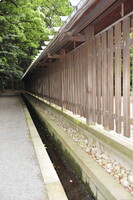Meiji Jingu
Ito, Chuta

Download1A2-J-T-MJS-G12_cp.jpg (552.2Kb)
Alternative Titles
Meiji Shrine
明治神宮
Date
1915-1926Description
Fence and portico over water channel near the Kaguraden (Hall of Shinto Music and Dance, built 1990-1993); The Meiji period that coincides with the rule of emperor Mutsuhito, called Meiji, from 1868 to 1912. The Meiji Jingu located in Shibuya, Tokyo, is the Shinto shrine that is dedicated to the deified spirits of Emperor Meiji and his wife, Empress Shōken. (A jingu is specifically a Shinto shrine connected to the Imperial House of Japan.) Construction began in 1915 under Itō Chūta, and the shrine was built in the traditional nagare-zukuri style and is made up primarily of Japanese cypress and copper. It was formally dedicated in 1920, completed in 1921, and its grounds officially finished by 1926. The original building was destroyed during the Tokyo air raids of World War II. The present iteration of the shrine was funded through a public fund raising effort and completed in October, 1958. Meiji Shrine is located in a forest that covers an area of 700,000 square-meters (about 175 acres). The Naien is the inner precinct, which is centered on the shrine buildings and includes a treasure museum. The Gaien is the outer precinct, which includes the Meiji Memorial Picture Gallery, the National Stadium and Meiji Memorial Hall. Source: Wikipedia; http://en.wikipedia.org/wiki/Main_Page (accessed 7/19/2012)
Type of Work
historic site; temple; shrine (structure)Subject
architecture, death or burial, funerary art, deities, rulers and leaders, parks (recreation areas), Restoration and conservation, World War, 1939-1945, arboretum, Meiji
Rights
Rights Statement
Licensed for educational and research use by the MIT community only